記錄一下MySql update會鎖定哪些範圍的資料
1、背景
在專案中,我們經常使用到update語句,那麼update語句會鎖定表中的那些記錄呢?此處我們通過一些簡單的案例來模擬下。此處是我自己的一個理解,如果那個地方理解錯了,歡迎指出
2、前置知識
2.1 資料庫的隔離級別
mysql> show variables like 'transaction_isolation';
+-----------------------+-----------------+
| Variable_name | Value |
+-----------------------+-----------------+
| transaction_isolation | REPEATABLE-READ |
+-----------------------+-----------------+
1 row in set (0.00 sec)
2.2 資料庫版本
mysql> select version();
+-----------+
| version() |
+-----------+
| 8.0.28 |
+-----------+
1 row in set (0.00 sec)
2.3 資料庫的儲存引擎
mysql> show variables like '%storage_engine%';
+---------------------------------+-----------+
| Variable_name | Value |
+---------------------------------+-----------+
| default_storage_engine | InnoDB |
| default_tmp_storage_engine | InnoDB |
| disabled_storage_engines | |
| internal_tmp_mem_storage_engine | TempTable |
+---------------------------------+-----------+
4 rows in set (0.01 sec)
2.4 鎖是加在記錄上還是索引上
鎖是加在索引上,那如果表中沒有建立索引,是否就是加在表上的呢?其實不是,也是加在索引的,會存在一個預設的。
Record locks always lock index records, even if a table is defined with no indexes. For such cases, InnoDB creates a hidden clustered index and uses this index for record locking
參考連結: https://dev.mysql.com/doc/refman/8.0/en/innodb-locking.html
2.5 update...where加鎖的基本單位是
UPDATE ... WHERE ... sets an exclusive next-key lock on every record the search encounters
此處可以理解加鎖的單位是: next-key鎖
2.6 行級鎖
2.6.1 Record Locks
記錄鎖,即只會鎖定一條記錄。其實是鎖定這條記錄的索引。
A record lock is a lock on an index record. For example, SELECT c1 FROM t WHERE c1 = 10 FOR UPDATE; prevents any other transaction from inserting, updating, or deleting rows where the value of t.c1 is 10.
2.6.2 Gap Locks
間隙鎖,間隙鎖是在索引記錄之間的間隙上的鎖,即鎖定一個區間。前開後開區間,不包括記錄本身。
間隙鎖如果是使用單列唯一索引值進行更新的話,是會退化成Record Lock。
間隙鎖的目的:
- 防止新的資料插入到間隙中
- 防止已經存在的資料被更新到間隙中。
Gap locking is not needed for statements that lock rows using a unique index to search > for a unique row. (This
does not includethe case that the search condition includes only > some columns of amultiple-column unique index; in that case, gap locking does occur.)
2.6.3 Next-Key Locks
Next-Key Lock 是索引記錄上的記錄鎖和索引記錄之前的間隙上的間隙鎖的組合。也是鎖定一個區間,前開後閉區間。包括記錄本身。
如果索引值包括 1,5,10,30,那麼next key 鎖可能涵蓋如下區間
(negative infinity, 1]
(1, 115
(5, 10]
(10, 30]
(30, positive infinity)
negative infinity指的是負無窮。positive infinity指的是正無窮。
2.6.4 測試鎖表的表結構
create table test_record_lock
(
id int not null comment '主鍵',
age int null comment '年齡,普通索引',
name varchar(10) null comment '姓名,無索引',
constraint test_record_lock_pk
primary key (id)
)
comment '測試記錄鎖';
create index test_record_lock_age_index
on test_record_lock (age);
2.6.5 表中的測試資料
mysql> select * from test_record_lock;
+----+------+--------+
| id | age | name |
+----+------+--------+
| 1 | 10 | 張三 |
| 5 | 20 | 李四 |
| 8 | 25 | 王五 |
+----+------+--------+
3 rows in set (0.00 sec)
2.7 檢視資料庫中當前的鎖
select * from performance_schema.data_locks;
欄位解釋:
| 欄位 | 值 | 解釋 |
|---|---|---|
lock_type |
TABLE | 鎖是加在表上 |
| RECORD | 鎖加在記錄上 | |
lock_mode |
IX | 意向排他鎖 |
| X或者S | next-key lock 鎖定記錄本身和記錄之前的間隙 |
|
| X,REC_NOT_GAP | Record Lock 只鎖記錄自身 | |
| S,REC_NOT_GAP | Record Lock 只鎖記錄自身 | |
| X,GAP | gap lock | |
| X,INSERT_INTENTION | 插入意向鎖 | |
lock_data |
具體的某個數位 | 表示主鍵的值 |
| 值,值 | 第一個值:普通索引的值 第二個值:主鍵值 |
疑問:X,GAP是否可以理解成X鎖退化成了GAP鎖。
3、測試資料加鎖
3.1 唯一索引測試
此處適用單個欄位的唯一索引,不適合多個欄位的唯一索引
3.1.1 等值更新-記錄存在
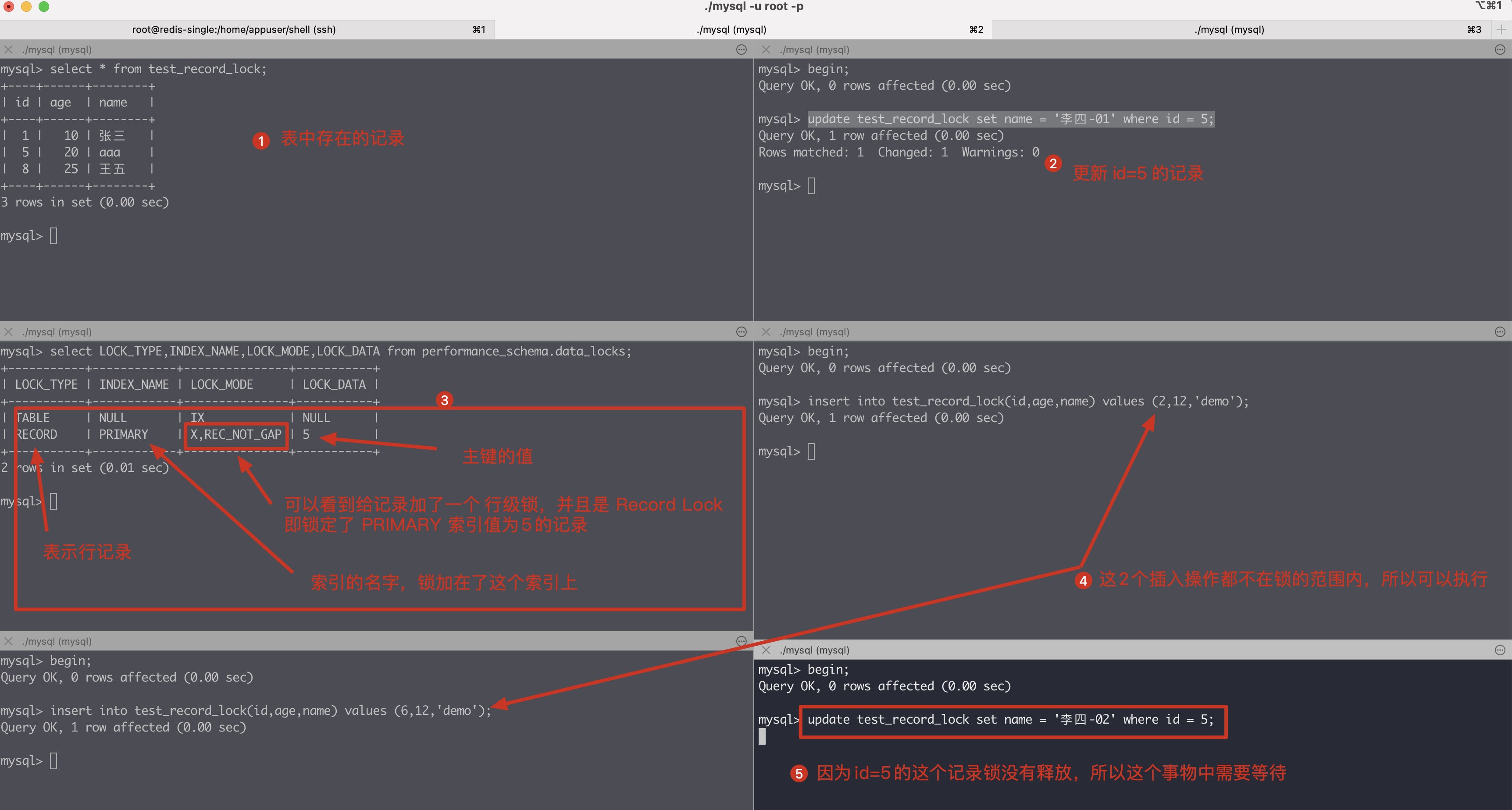
解釋:
- 加next-key lock,那麼鎖定的記錄範圍為 (1,5]。
- 因為是唯一索引,且查詢的值存在,next-key lock退化成record lock,即最終只鎖定了id=5的這一行資料。其餘的資料不影響。
3.1.2 等值查詢-記錄不存在-01
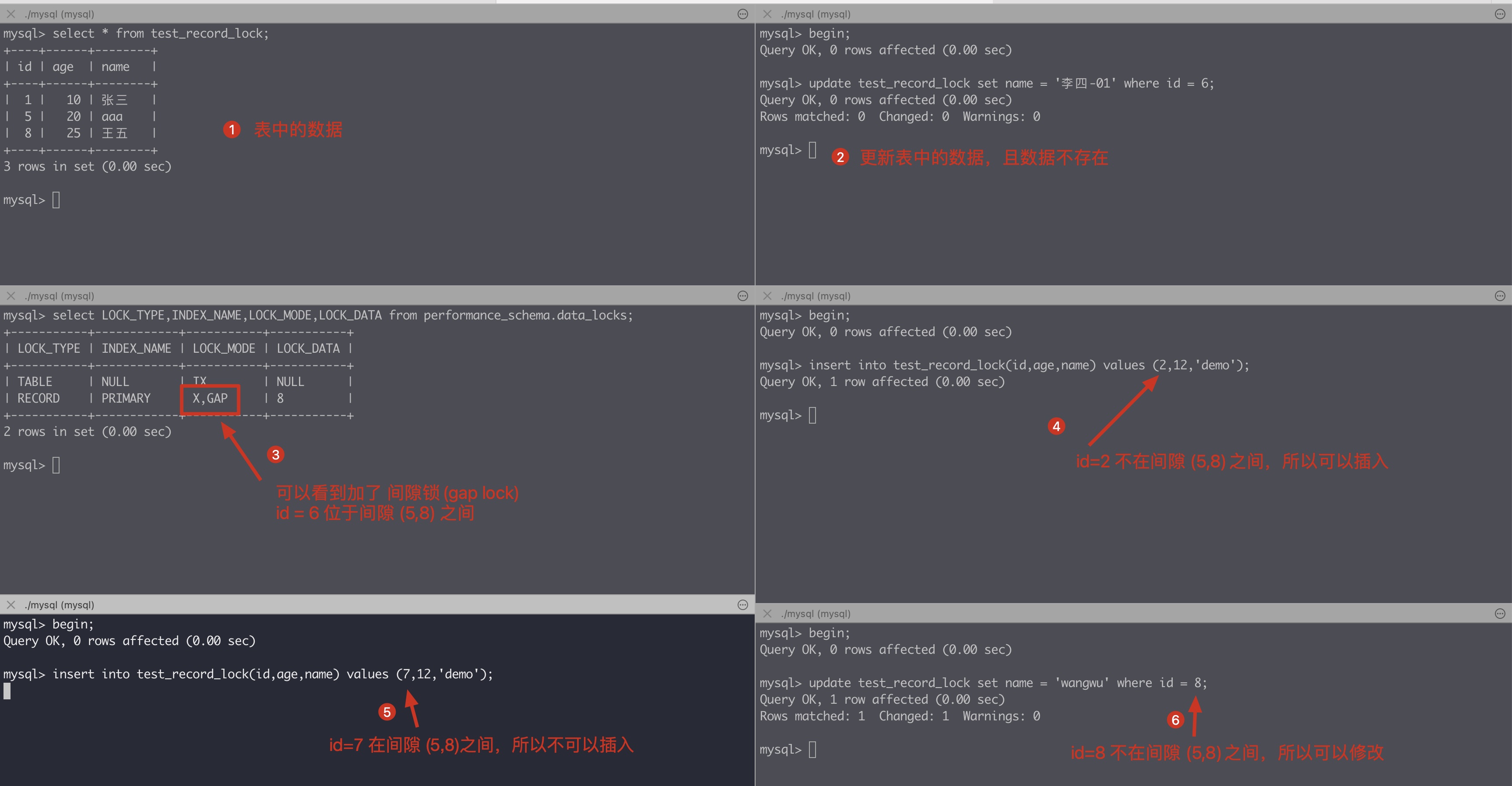
解釋:
- 加next-key lock,那麼鎖定的記錄範圍為 (5,8]。
- 因為是唯一索引,且查詢的值不存在,next-key lock退化成gap,即最終鎖定的資料範圍為(5,8)。其餘的資料不影響。
3.1.3 等值更新-記錄不存在-02
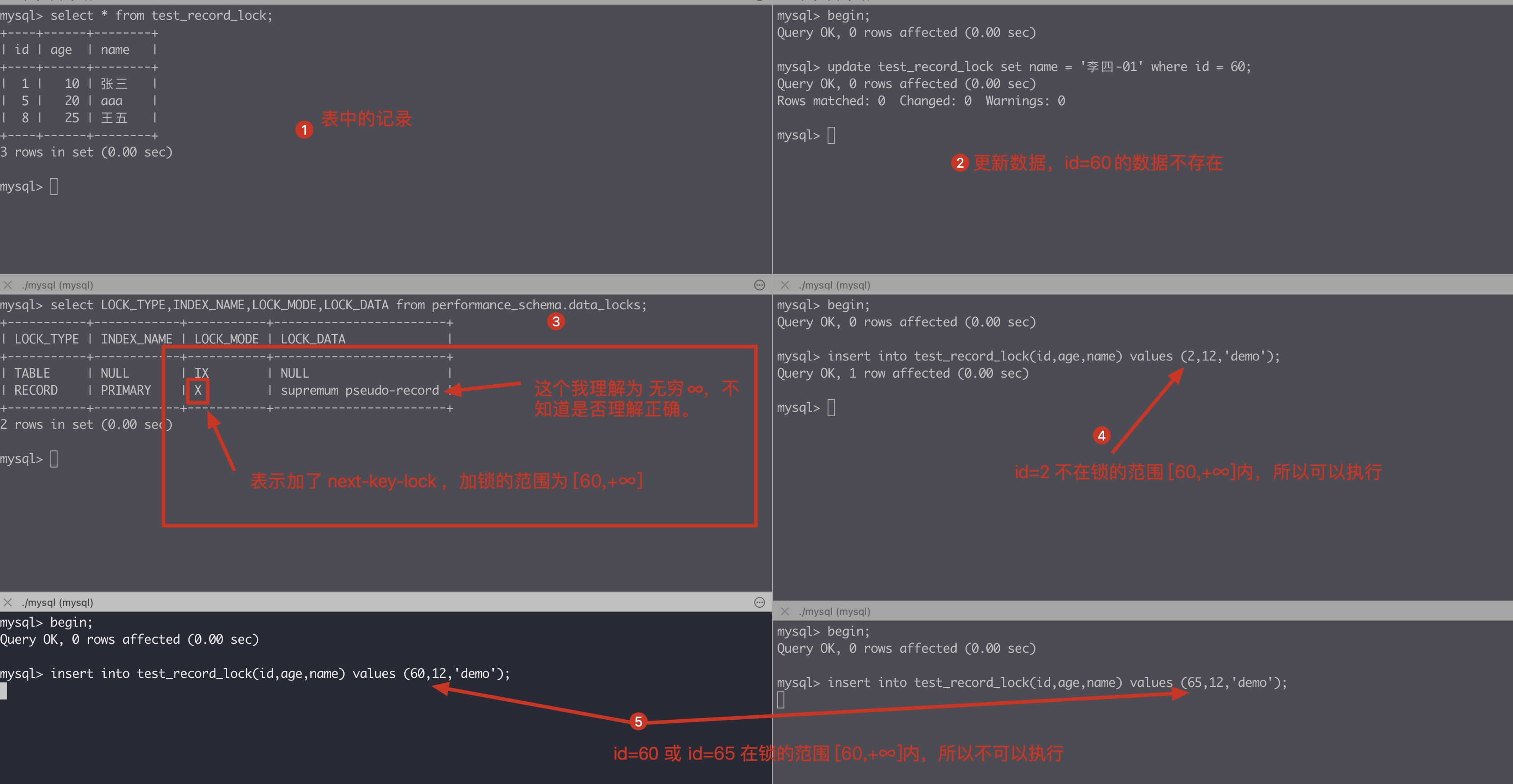
3.1.4 範圍更新
1、小於或等於最大臨界值
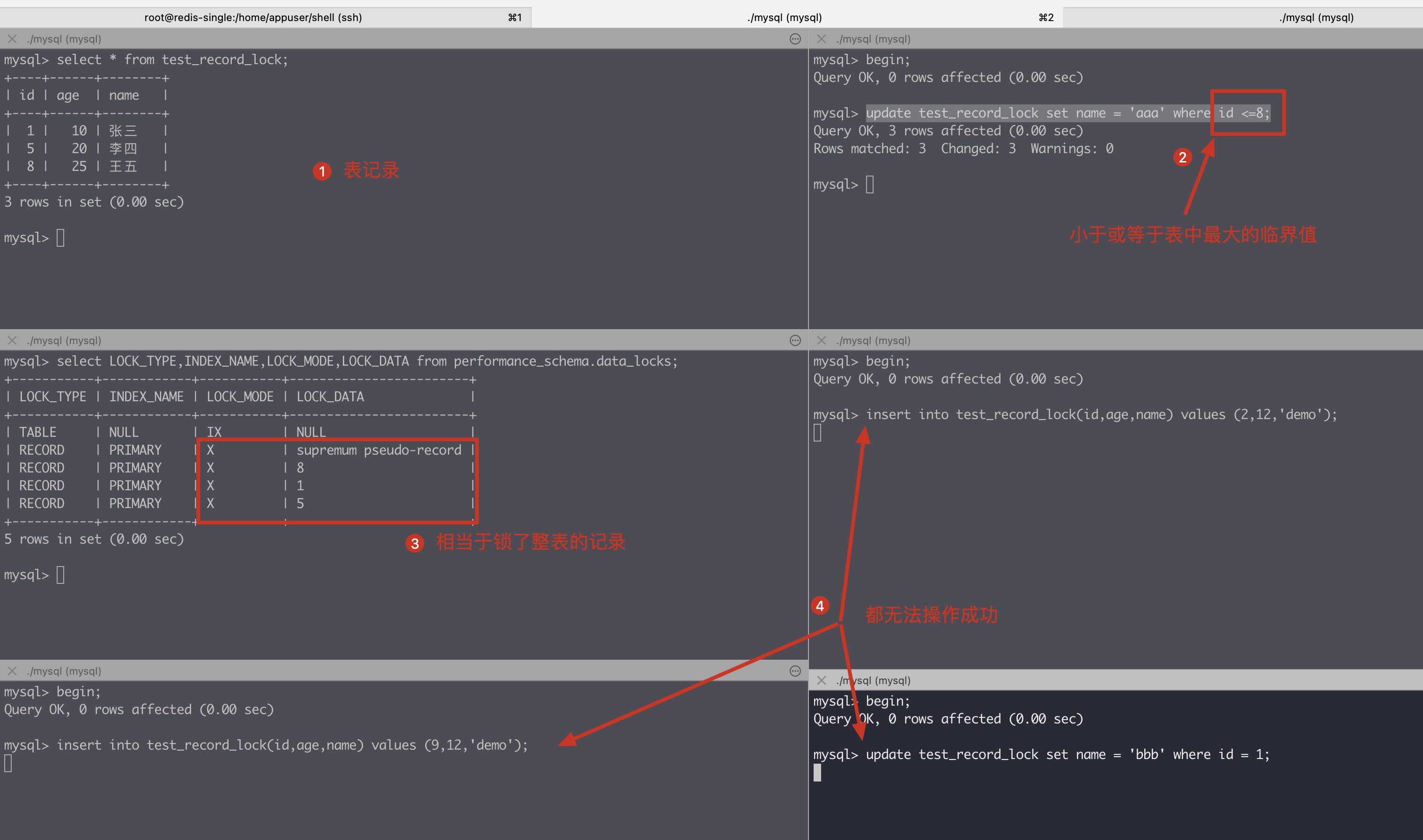
此時可以發現表中掃描到的記錄都加上了next key lock(鎖加在索引上)
2、大於或等於最小臨界值
mysql> begin;
Query OK, 0 rows affected (0.01 sec)
mysql> update test_record_lock set name = 'aaa' where id >= 1;
Query OK, 3 rows affected (0.00 sec)
Rows matched: 3 Changed: 3 Warnings: 0
mysql> select LOCK_TYPE,INDEX_NAME,LOCK_MODE,LOCK_DATA from performance_schema.data_locks;
+-----------+------------+---------------+------------------------+
| LOCK_TYPE | INDEX_NAME | LOCK_MODE | LOCK_DATA |
+-----------+------------+---------------+------------------------+
| TABLE | NULL | IX | NULL |
| RECORD | PRIMARY | X,REC_NOT_GAP | 1 |
| RECORD | PRIMARY | X | supremum pseudo-record |
| RECORD | PRIMARY | X | 8 |
| RECORD | PRIMARY | X | 5 |
+-----------+------------+---------------+------------------------+
5 rows in set (0.01 sec)
此時只可向表中插入比最小臨界值小的記錄。
3、正常範圍
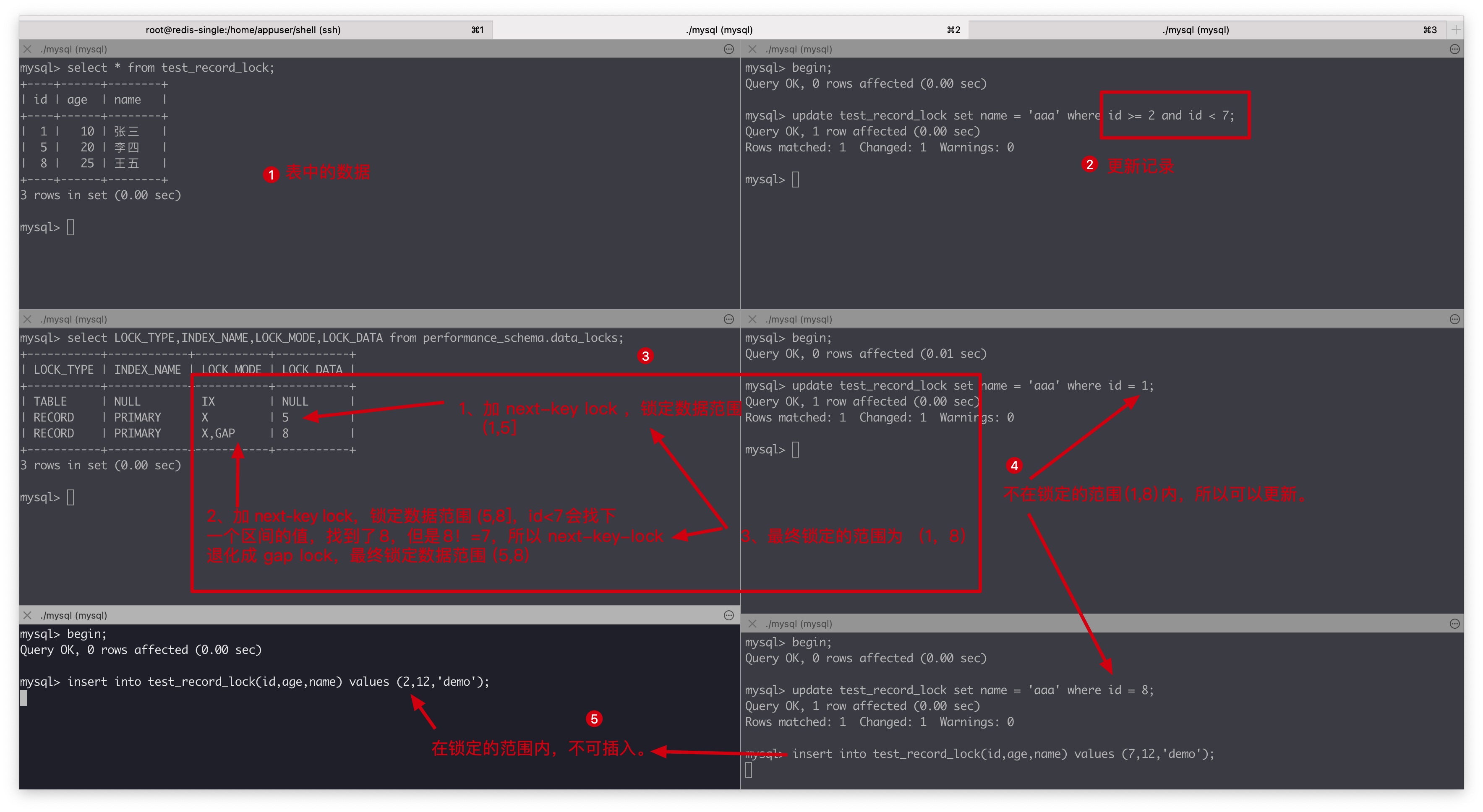
3.2 普通索引測試
3.2.1 等值更新-記錄存在

解釋:
- 先對普通索引
age加上next-key lock,鎖定的範圍是(10,20] - next-key lock還會鎖住本記錄,因此在id索引的值等於5上加了Record Lock
- 因為是普通索引並且值還存在,因此還會對本記錄的下一個區間增加間隙鎖 Gap Lock,鎖定的範圍為 (20,25)
3.2.2 等值更新-記錄不存在
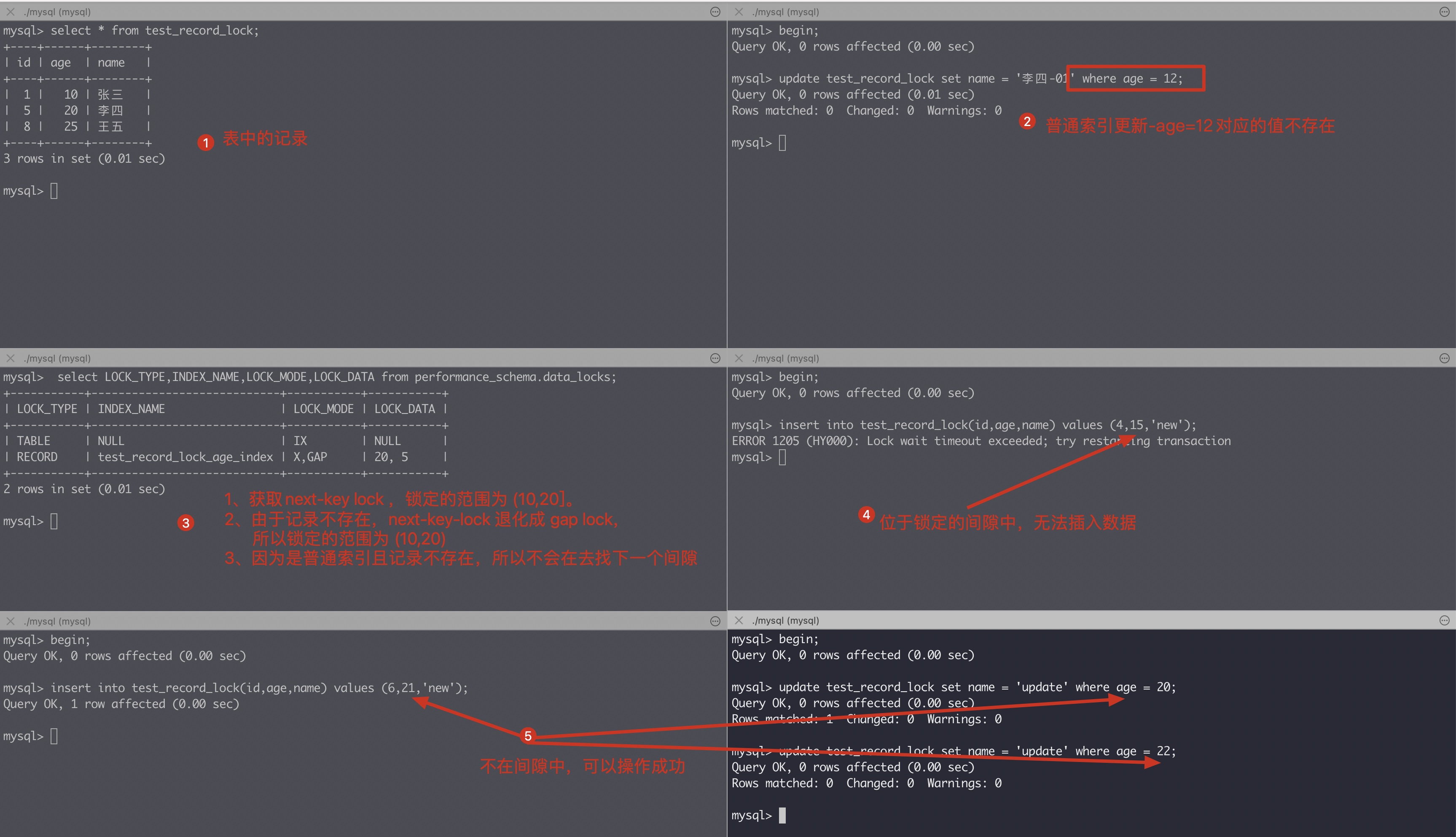
解釋:
- 獲取next-key lock 鎖定的範圍為 (10,20]
- 因為需要更新的記錄不存在,next-key lock退化成 gap lock,所以鎖定的範圍為(10,20)
- 因為是普通索引且記錄不存在,所以不需要再次查詢下一個區間。
3.2.3 範圍更新
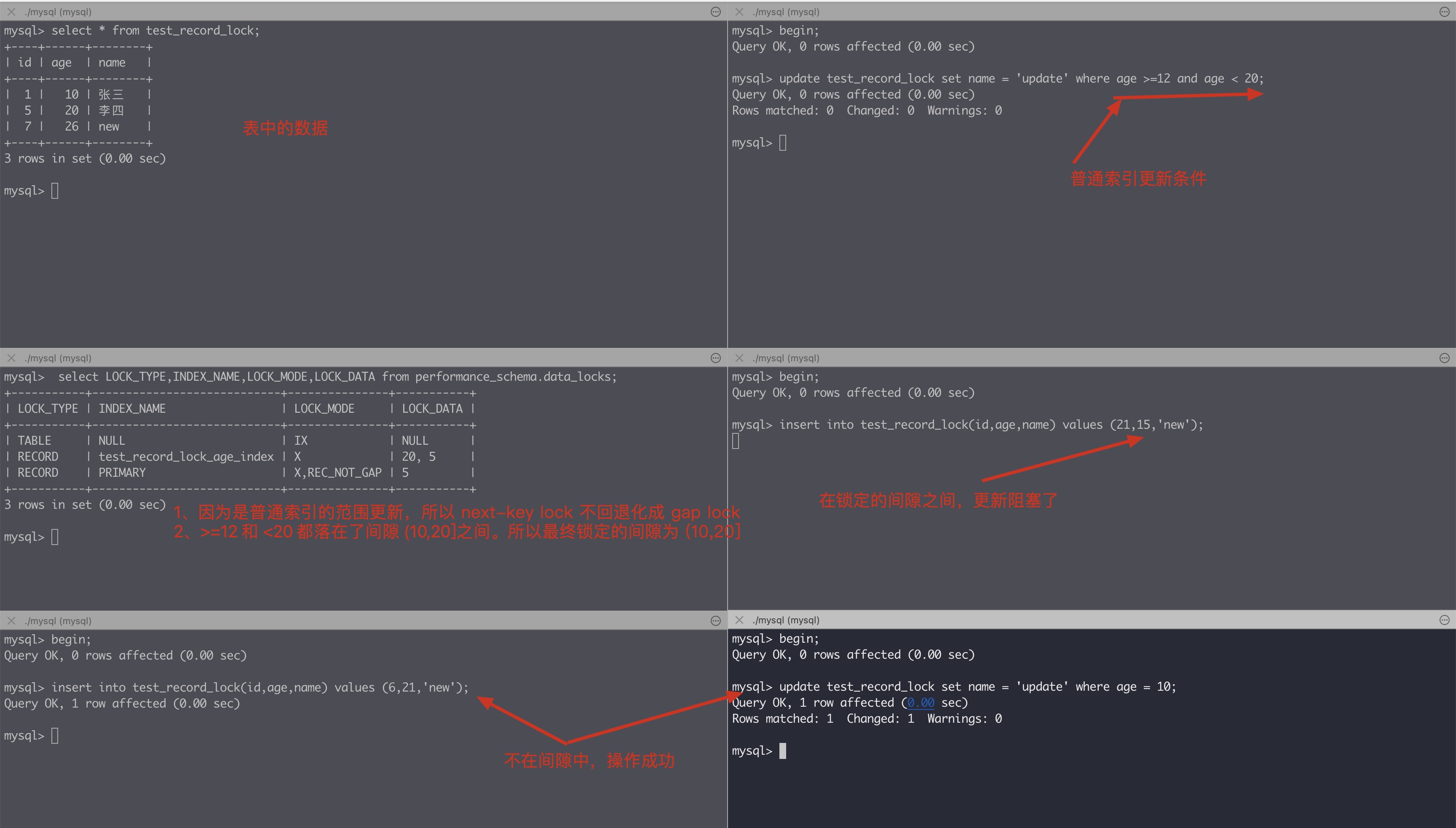
解釋:
- 普通索引的範圍更新,next-key-lock不回退化成 gap lock。
3.3 無索引更新
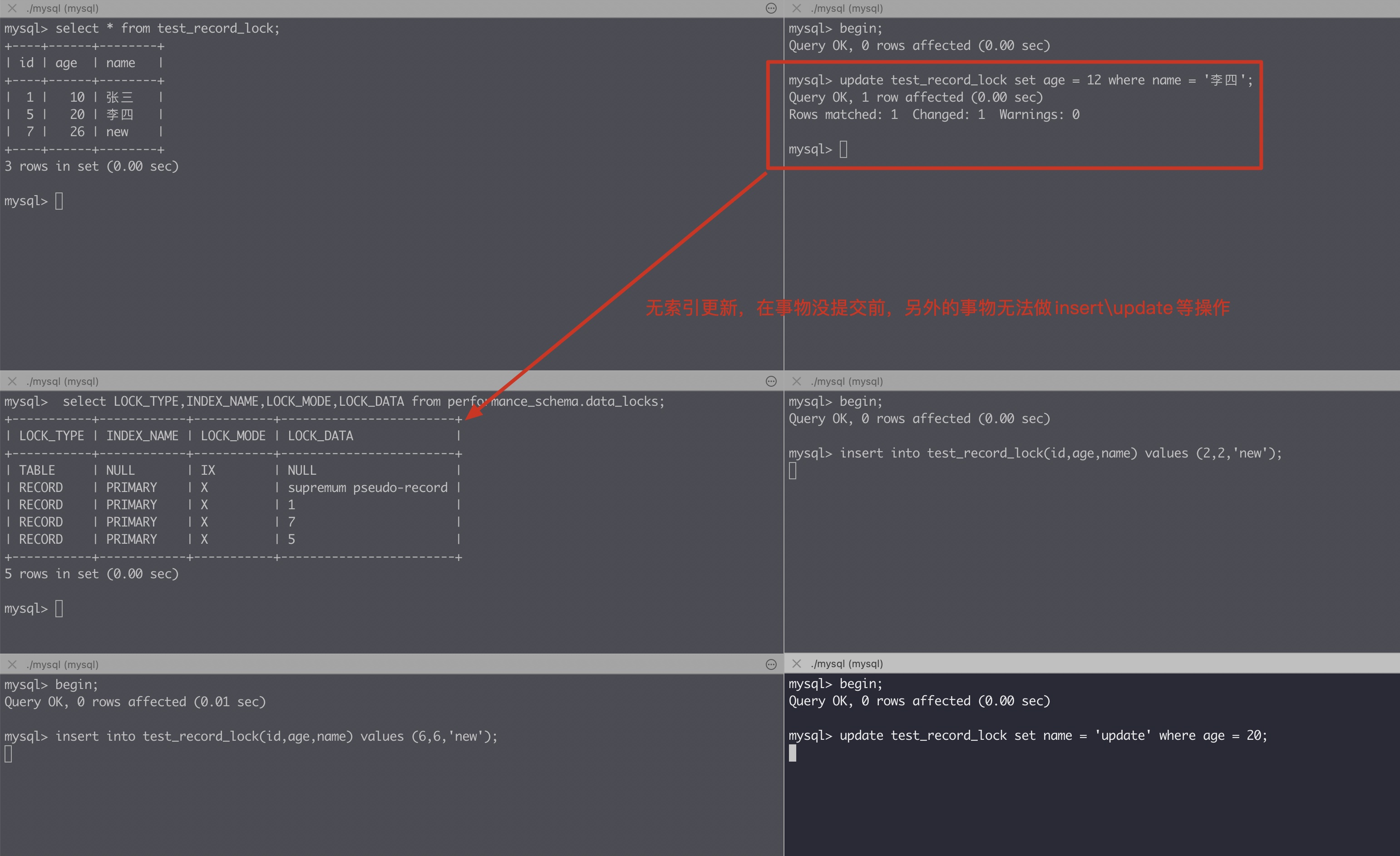
從上圖中可知,無索引更新資料表危險,需要謹慎處理。無索引更新,會導致全表掃描,導致將掃描到的所有記錄都加上next-key lock。
3、參考連結
1、https://dev.mysql.com/doc/refman/8.0/en/innodb-locking.html
2、https://dev.mysql.com/doc/refman/8.0/en/innodb-locking.html
本文來自部落格園,作者:huan1993,轉載請註明原文連結:https://www.cnblogs.com/huan1993/p/16407440.html